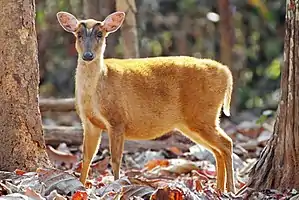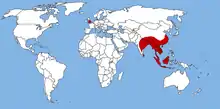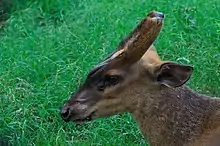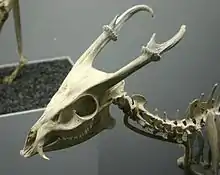Muntjac
Muntjacs (/mʌndʒɑːk/ MUN-jahk), also known as barking deer or rib-faced deer are small deer of the genus Muntiacus native to south and southeast Asia. Muntjacs are thought to have begun appearing 15–35 million years ago, with remains found in Miocene deposits in France, Germany[1] and Poland.[2] Most species are listed as Least Concern or Data Deficient by the IUCN although others such as the black muntjac, Bornean yellow muntjac and giant muntjac are Vulnerable, Near Threatened and Critically Endangered respectively.[3][4]
| Muntjac Temporal range: Miocene to present | |
|---|---|
 | |
| Indian muntjac | |
| Scientific classification | |
| Kingdom: | Animalia |
| Phylum: | Chordata |
| Class: | Mammalia |
| Order: | Artiodactyla |
| Family: | Cervidae |
| Subfamily: | Cervinae |
| Tribe: | Muntiacini |
| Genus: | Muntiacus Rafinesque, 1815 |
 | |
| Geographic range | |
Name
The present name is a borrowing of the Latinized form of the Dutch muntjak, which was borrowed from the Sundanese mēncēk. The Latin form first appeared as Cervus muntjac in Zimmerman in 1780.[5][6] An erroneous alternative name of 'Mastreani deer' has its origins in a mischievous Wikipedia entry from 2011 and is incorrect.[7]
Description


The present-day species are native to Asia and can be found in India, Sri Lanka, Myanmar, Vietnam, the Indonesian islands, Taiwan and Southern China. They are also found in the lower Himalayas (Terai regions of Nepal and Bhutan).
An invasive population of Reeves's muntjac exists in the United Kingdom and in some areas of Japan (the Bōsō Peninsula and Izu Ōshima Island).[8] In the United Kingdom, wild deer descended from escapees from the Woburn Abbey estate around 1925.[9] Muntjac have expanded very rapidly, and are now present in most English counties and have also expanded their range into Wales, although they are less common in the north-west. The British Deer Society coordinated a survey of wild deer in the UK between 2005 and 2007, and they reported that muntjac deer had noticeably expanded their range since the previous census in 2000.[10] It is anticipated that muntjac may soon become the most numerous species of deer in England and may have also crossed the border into Scotland with a couple of specimens even appearing in Northern Ireland in 2009; they have been spotted in the Republic of Ireland in 2010, almost certainly having reached there with some human assistance.
Inhabiting tropical regions, the deer have no seasonal rut, and mating can take place at any time of year; this behaviour is retained by populations introduced to temperate countries. Males have short antlers, which can regrow, but they tend to fight for territory with their "tusks" (downward-pointing canine teeth). The presence of these "tusks" is otherwise unknown in native British wild deer and can be an identifying feature to differentiate a muntjac from an immature native deer. Water deer also have visible tusks but they are much less widespread.
.jpg.webp)
Muntjac are of great interest in evolutionary studies because of their dramatic chromosome variations and the recent discovery of several new species. The Indian muntjac (M. muntjak) is the mammal with the lowest recorded chromosome number: The male has a diploid number of 7, the female only 6 chromosomes. Reeves's muntjac (M. reevesi), in comparison, has a diploid number of 46 chromosomes.[11]
Species
The genus Muntiacus has 12 recognized species:
- Indian muntjac or common muntjac or kakar,[12] Muntiacus muntjak
- Reeves's muntjac or Chinese muntjac, M. reevesi
- Hairy-fronted muntjac or black muntjac, M. crinifrons
- Fea's muntjac, M. feae
- Bornean yellow muntjac, M. atherodes
- Roosevelt's muntjac, M. rooseveltorum
- Gongshan muntjac, M. gongshanensis
- Giant muntjac, M. vuquangensis
- Truong Son muntjac M. truongsonensis
- Leaf muntjac M. putaoensis
- Sumatran muntjac M. montanus
- Pu Hoat muntjac M. puhoatensis
See also
References
- Baynes, T. S.; Smith, W.R., eds. (1884). . Encyclopædia Britannica. 17 (9th ed.). New York: Charles Scribner's Sons.
- Czyżewska, Teresa; Stefaniak, Krzysztof (December 1994). "Euprox furcatus (Hensel, 1859) (Cervidae, Mammalia) from Przeworno (Middle Miocene, Lower Silesia, Poland)" (PDF). Acta Zoologica Cracoviensia. 37 (1): 55–74.
- https://www.iucnredlist.org/species/136551/22165292
- https://www.iucnredlist.org/species/42190/56005589
- "muntjac, n.", Oxford English Dictionary, 2003.
- Von Zimmerman, Eberhard August Wilhelm (1780), Geographische Geschichte des Menschen, und der Allgemein Verbreiteten Vierfussigen Thiere, II, p. 131. (in German)
- Smith-Jones, C. (2020), 'Mastreani deer, a very modern hoax', The British Deer Society: Deer Journal Summer 2020 p25
- "Reeves's (or Chinese) Muntjac / Invasive Species of Japan". www.nies.go.jp. Retrieved 7 April 2018.
- Whitehead, George Kenneth (1964). The deer of Great Britain and Ireland: an account of their history, status and distribution. London: Routledge & K. Paul. pp. .
- Deer Distribution Survey 2007 Archived 23 September 2015 at the Wayback Machine The British Deer Society. Retrieved 6 September 2011.
- Wurster, D. H.; Benirschke, K. (1970). "Indian Momtjac, Muntiacus muntiak: A Deer with a Low Diploid Chromosome Number". Science. 168 (3937): 1364–1366. Bibcode:1970Sci...168.1364W. doi:10.1126/science.168.3937.1364. PMID 5444269. S2CID 45371297.
- "Fauna of Corbett National Park". Internet Archive. Archived from the original on 4 July 2014. Retrieved 24 March 2015.CS1 maint: unfit URL (link)
External links
| Wikimedia Commons has media related to Muntiacus. |
- BBC Wales Nature: Muntjac deer article
 Texts on Wikisource:
Texts on Wikisource:
- "Muntjac". New International Encyclopedia. 1905.
- "Muntjac". Encyclopædia Britannica (11th ed.). 1911.
- "Muntjac". Collier's New Encyclopedia. 1921.